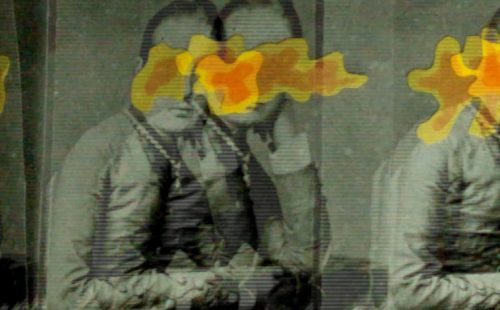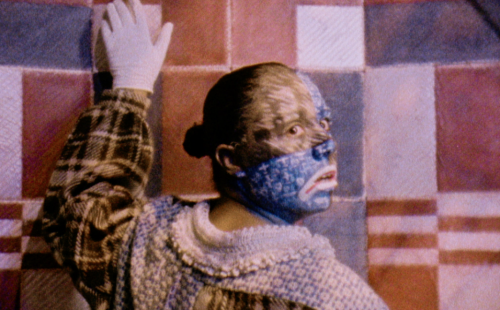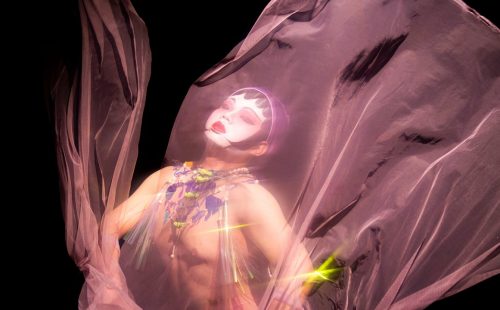
‘Young man!’ booms the voice of a man in uniform. Disregard your age and gender; he’s talking to you and, with a realization too sudden to sink, you know it. ‘There’s no need to feel down’ he continues ‘I said young man, pick yourself off the ground.’ You can breathe a sigh of relief — he’s doing his good-time-cop routine. You are assisting in our celebrations – not under arrest at this time.
Eight years before the release of YMCA by Village People, Louis Althusser used the scenario of being hailed by a cop in the street, addressed as ‘Hey, you there’, to illustrate his theory of interpellation — the process whereby the individual is made a subject by ideology. It probably never occurred to him that such interpellation could spur party goers to enthusiastically contort their own upper bodies into an unmistakable sequence of letters. His analysis might have benefitted from revision in light of this.
YMCA makes two brief but significant appearances in the Selected 8 screenings. It’s in the first of three movements in Gaby by Hannah Quinlan and Rosie Hastings, a film broadly about the relations between queer culture, urban space, policing and dance music. it accompanies footage of police officers at a Pride parade, not in their usual capacity but as participants; as the LGBTQ friendly face of the force. Crucially, though, they remain on duty and will presumably act accordingly, should they feel the need. Playing through the opening verses as a vocal edit only, Gaby’s YMCA is heard in its most stentorian aspect first. When a backing track does commence, it’s dystopian industrial tinged techno, all boots in lockstep, dissonant with the buoyant gregarious brass we’re used to.
YMCA pivots elegantly between Gaby and Prime Time, a tenderly but tenaciously voyeuristic people watching exercise by Rob Crosse. In the latter, it’s heard in the bar of a cruise ship with a contingent of late middle aged gay men on board. The camera lovingly lingers over these men; their paunches and thickets of wiry silver body hair, but also their fastidious ticks and routines, like shaving around a carefully contoured beard, absent-mindedly faltering mid drink order or fidgeting nervously before taking to the dancefloor.
The erotic languor and sensitivity of Prime Time couldn’t be more distant from the punitive institutional space of Brother to Brother by Imran Perretta. It presents the official mandate to look, that is to profile, as routinely ideological, vestigially colonial. Like the artist, the customs officer who carried out a search that partly inspired the film was a man of South Asian extraction — a cruel irony, especially given that the second parallel movement within the film is the mobile, remote controlled colonial gaze of the drone. While asymmetrical trade/war runs rough-shod around the globe, people of colour are left to police each other in locked rooms at airports.
The subject of such a colonial gaze negotiates some paradoxical demands. They must split into simultaneous visibility and invisibility, must vanish from all elevated forums of public life and national consensus. At the same time, they must be thoroughly observable, knowable and legible. ‘If we examine the process of understanding people and ideas from the perspective of Western thought, we discover that its basis is the requirement for transparency’ said Edouard Glissant. A key term in his lexicon was opacity; he insisted upon the right to it.
Afro-Glitch by Kamile Ofoeme suggests a black opacity as paradoxical as the scrutiny it counters; the paradox of making oneself unseeable in a state of the most baroque ostentation. The artist vigilantly holds and follows my gaze, draped in printed fabrics that look like ethnographic dazzle camo for confounding the focus of surveillance technology. He also wears a gold chain with small pendants of a decorative frame — the kind that could frame a classical European painting or a mirror or nothing. Though a baby pink ski mask largely obscures his face, I still read fatigue in his heavy-lidded eyes. He could use a break, but as long as I look at him, he’ll look back.
Maybe Gery Georgieva and Jala Wahid propose similar opacities or illegibilities in The Blushing Valley and Oh Leander! respectively. To describe The Blushing Valley as a pastiche of Carnival Queen style ceremonies common to any number of world cultures is probably adequate but shuts it down somewhat. The artist performs a feminine archetype in Balkan pop-folk creole. A common geopolitical imaginary of the West registers land with Black Sea shores rather mysteriously, voided by the falling Soviet Bloc unreplaced by something similarly monolithic, somehow both Europe and the Middle East, neither entirely one nor the other. The Blushing Valley is wise to this uncertainty.
Oh Leander! creates the impression of being both a formidable mistranslation or distortion, and loyalty at the same time. It takes as its soundtrack a heavily manipulated Kurdish ballad, ‘translated’ (with evident and conspicuous licence) into ecstatic, image-rich prose that’s equally sensual and absurd. The backdrop looks like meat sinking into a hidden grinder. if there’s no grinder, perhaps it’s just being massaged by unseen hands, and if not meat then maybe it’s some heavily rendered meat product like spam or dog food, already worked over, already denatured, distant from the ever-retreating origin. Not only can I not measure that distance, I enjoy my disorientation, but it’s surreptitiously barbed. To an orientalist reading, the name for this seductive lack puts me on a deeply problematic footing, though not without good cause. The name is mystique.
The distance is less abstract in People Say It’s Fireworks by Tim Bowditch, Matthew de Kersaint Giraudeau and Sybella Perry. ‘Living at a fair distance from the objects of your desire is not a rich life’ rues the narrator ‘so one must bring together things that can stand in their place.’ The things, in this instance, are a fabrication of Mount Vesuvius and a re-enactment of its eruption, which appears to take a most rudimentary coke-and-mentos level science as its motive power.
In context, a striking shift has occurred here. The work discussed thus far largely coheres around people looking at (reading, monitoring, profiling) other people. This film is ostensibly about people looking at an inanimate thing. However, optics have subtly re-situated themselves. Whether it’s down to the ceremonious narration or the panoptic spatial organisation of the event, there’s a palpable and increasing sense as spectators throng around the volcano that it’s preparing to look back.





